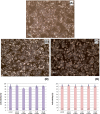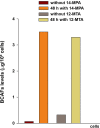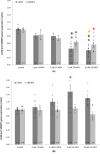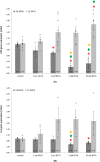Branched-chain fatty acids affect the expression of fatty acid synthase and C-reactive protein genes in the hepatocyte cell line
- PMID: 37850622
- PMCID: PMC10619197
- DOI: 10.1042/BSR20230114
Branched-chain fatty acids affect the expression of fatty acid synthase and C-reactive protein genes in the hepatocyte cell line
Abstract
Fatty acids (FAs) are known to play an important role in human metabolism; however, still little is known about the functions of certain FA classes present in blood at relatively low concentrations. Examples of such compounds include branched-chain fatty acids (BCFAs). Recently, lowered BCFAs blood concentration was noticed in obese patients. An inverse correlation was found between serum concentrations of BCFAs and triglyceride levels, as well as C-reactive protein (CRP) concentration. Obesity is the most frequently observed component of metabolic syndrome and both disorders are accompanied by the dysregulation of FAs metabolism. However, not all of them are well understood. Our study is the first attempt at presenting the opposite effects of an iso-BCFA (14-methylpentadecanoic acid, 14-MPA) and an anteiso-BCFA (12-methyltetradecanoic acid, 12-MTA) on selected genes related to fatty acid synthesis and inflammation: FASN, SREBP1, CRP, and IL-6 in the HepG2 cell line. We observed lowered expression of FASN, SREBP1, CRP, and IL-6 in cells treated with 14-MPA in comparison with control cells. In contrast, supplementation with 12-MTA caused opposite effects: increased mRNA levels of FASN, CRP, and IL-6. 12-MTA did not influence SREBP1 expression. The results of our preliminary study may suggest potential benefits of the supplementation of iso-BCFAs in obese patients, for inflammation and hypertriglyceridemia prevention.
Keywords: branched-chain fatty acids; hepatocytes; inflammation; nutrition; obesity; triglycerides.
© 2023 The Author(s).
Conflict of interest statement
The authors declare that there are no competing interests associated with the manuscript.
Figures




Similar articles
-
Branched-Chain Fatty Acids Alter the Expression of Genes Responsible for Lipid Synthesis and Inflammation in Human Adipose Cells.Nutrients. 2022 May 31;14(11):2310. doi: 10.3390/nu14112310. Nutrients. 2022. PMID: 35684110 Free PMC article.
-
A comprehensive study of serum odd- and branched-chain fatty acids in patients with excess weight.Obesity (Silver Spring). 2016 Aug;24(8):1669-76. doi: 10.1002/oby.21560. Epub 2016 Jun 29. Obesity (Silver Spring). 2016. PMID: 27355152
-
Branched- Chain Fatty Acids and Obesity: A Narrative Review.Nutr Rev. 2025 Jul 1;83(7):1314-1326. doi: 10.1093/nutrit/nuaf022. Nutr Rev. 2025. PMID: 40207993 Review.
-
The Effect of One Anastomosis Gastric Bypass on Branched-Chain Fatty Acid and Branched-Chain Amino Acid Metabolism in Subjects with Morbid Obesity.Obes Surg. 2020 Jan;30(1):304-312. doi: 10.1007/s11695-019-04157-z. Obes Surg. 2020. PMID: 31440954 Clinical Trial.
-
Branched-Chain Fatty Acids-An Underexplored Class of Dairy-Derived Fatty Acids.Nutrients. 2020 Sep 20;12(9):2875. doi: 10.3390/nu12092875. Nutrients. 2020. PMID: 32962219 Free PMC article. Review.
Cited by
-
Full-fat yogurt compared with non-fat yogurt reduces blood triacylglycerol concentrations and lowers the triacylglycerol content in specific lipoprotein subclasses in adults with prediabetes: an exploratory analysis of a randomized-controlled trial.Lipids Health Dis. 2025 Jun 5;24(1):201. doi: 10.1186/s12944-025-02616-4. Lipids Health Dis. 2025. PMID: 40474187 Free PMC article. Clinical Trial.
-
Fatty Acid Profile in the Liver of Mice with Early- and Late-Onset Forms of Huntington's Disease.Int J Mol Sci. 2025 Jul 28;26(15):7304. doi: 10.3390/ijms26157304. Int J Mol Sci. 2025. PMID: 40806436 Free PMC article.
-
Lipids as key biomarkers in unravelling the pathophysiology of obesity-related metabolic dysregulation.Heliyon. 2025 Jan 23;11(3):e42197. doi: 10.1016/j.heliyon.2025.e42197. eCollection 2025 Feb 15. Heliyon. 2025. PMID: 39995923 Free PMC article.
-
Divergent effects of monomethyl branched-chain fatty acids on energy metabolism and insulin signaling in human myotubes.J Lipid Res. 2025 Mar;66(3):100764. doi: 10.1016/j.jlr.2025.100764. Epub 2025 Feb 24. J Lipid Res. 2025. PMID: 40010610 Free PMC article.
References
-
- O'Donnell A.G., Goodfellow M. and Minnikin D.E. (1982) Lipids in the classification of Nocardioides: reclassification of Arthrobacter simplex (Jensen) lochhead in the genus Nocardioides (Prauser) emend. O'Donnell et al. as Nocardioides Simplex Comb. Nov. Arch Microbiol. 133, 323–329 10.1007/BF00521299 - DOI - PubMed
Publication types
MeSH terms
Substances
LinkOut - more resources
Full Text Sources
Research Materials
Miscellaneous

